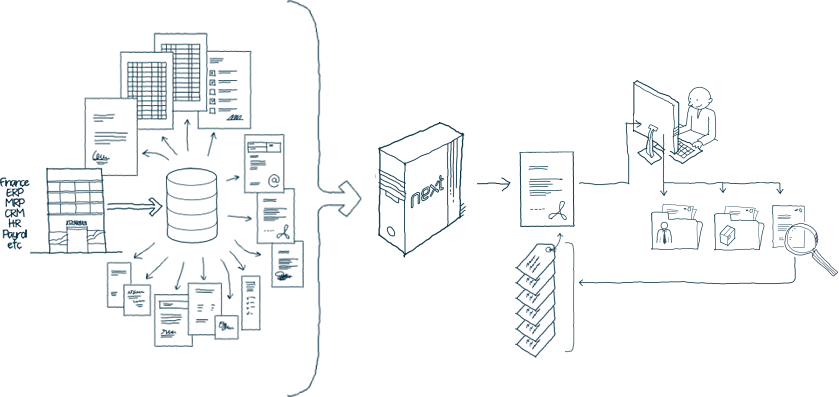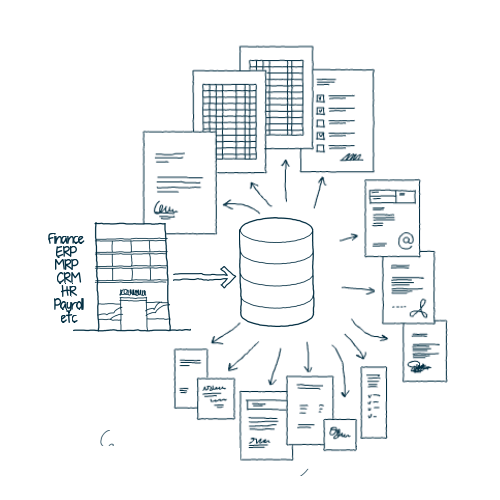Blog
5 signs you have outgrown your archive solution
Even if you don't have a Business Output Archiving Strategy. Or ever wanted one. It might be time to reconsider.
You have one or more Business systems in place. Finance, ERP, CRM, MRP, Payroll etc.
They all generate documents: Quotations, confirmations, sales invoices, reminders, statements, GL posting lists, sales statistics, pay slips and more.
Some you keep in-house, and others you distribute to customers, suppliers, partners, and your employees on paper by mail, and electronically by fax, EDI, and email.
We’re seeing a trend - almost a MEGA trend - that more and more of our business transactions are online and electronic. Less paper and more bits and bytes.
Despite this MEGA trend, we only see a 2% annual decline in the use of cut sheet paper in the western world. And at the same time the number of electronic documents is going through the roof.
Copies to keep for years
 You need to keep copies of all of these business output documents – paper or electronic. First of all because of legislation. Corporate legislation, TAX and VAT legislation. SOX, EuroSOX, and now also money laundering laws.
You need to keep copies of all of these business output documents – paper or electronic. First of all because of legislation. Corporate legislation, TAX and VAT legislation. SOX, EuroSOX, and now also money laundering laws.
You also need the copies in your daily operation. Documents contain vital corporate knowledge. Knowledge you’d miss badly if it was gone.
And to serve your customers. Copies of orders, sales invoices, and statements. They rightfully expect you to do so. And so do your employees with their payroll.
The best way
I know … you have been doing this for years. But are you sure that you are doing it the best possible way?
To get a sneak peek into your company we have developed a list called
”Five signs that you have outgrown your current business output archive strategy”
- Wall of binders in accounting
- PDF and XML files on your file server
- Local archives throughout the company
- Calling on overdue invoices more than once
- People without access to all relevant documents
41 % of companies keep paper copies of business system documents
Wall of binders in accounting
Imagine you and I walking into your accounting department and we find a wall of binders or filing cabinets. I’d say you are busted. Big time. You’d be burning money every single day.
44 % of companies archive business system documents on file servers.
PDF and XML files on your file server
If instead we have a look at your file servers, and find folder after folder with XML and PDF files, it shows you have moved beyond paper. But I’d still say you are busted. You spend a lot of time organizing files in folders and subfolders and even purging obsolete documents. At the same time coworkers and clients have limited or no access to the files. And the files aren’t protected from internal and external prying eyes
Only 2% annual decline in cut sheet paper.
Local archives throughout the company
Let’s instead walk through your offices. Preferably also visit some away from headquarters. If we find binders on shelves in more than a single room, I’d say we’re on to something. People tends to take copies and make local archives, when it’s too complicated or simply too slow to get at the documents in the corporate archive.
2.55 is the number of calls it takes to get hold of the person responsible for paying your invoice.
Calling on overdue invoices more than once
Passing though the Accounts Receivable (AR) Department, I’ll pay special attention to the people calling customers with overdue invoices. If they have to call more than once, it might very well be because the assistant is not able to finish the job while on the phone the first time. When people pull the trick ”That invoice we never got in the first place”, it’s essential that you have immediate access to documents, and are able to ”finish the job while on the phone”, instead of getting back later.
24 % of coworkers need to go to a physical archive to get hold of business system documents.
People without access to all relevant documents
Even if your AR staff have access to the documents they need in process of calling customers with overdue invoices, it might not be the case for everyone else. If your sales reps normally use the CRM system, they probably don’t have access to documents in Finance. And if Management use the Business Intelligence app, they may lack access to documents both in CRM and Finance.
And what about your customers. Do they have access to copies of sales invoices without bothering you? If you recognize ANY of the five signs. You should definitely have a look at your business output archive strategy.
Fact source: AIIM White Paper: Document Output Management - so much more than print
No big surprise
It’s probably no big surprise to anyone that our take is, that the best way is simply to implement a single shared business archive – preferably Multi Support Next.

One corporate archive available for everyone
Right now we are running a campaign trying to help companies evaluate their current “business output archive strategy”. See the actual campaign. Or simply look up our Next Business Output product.









